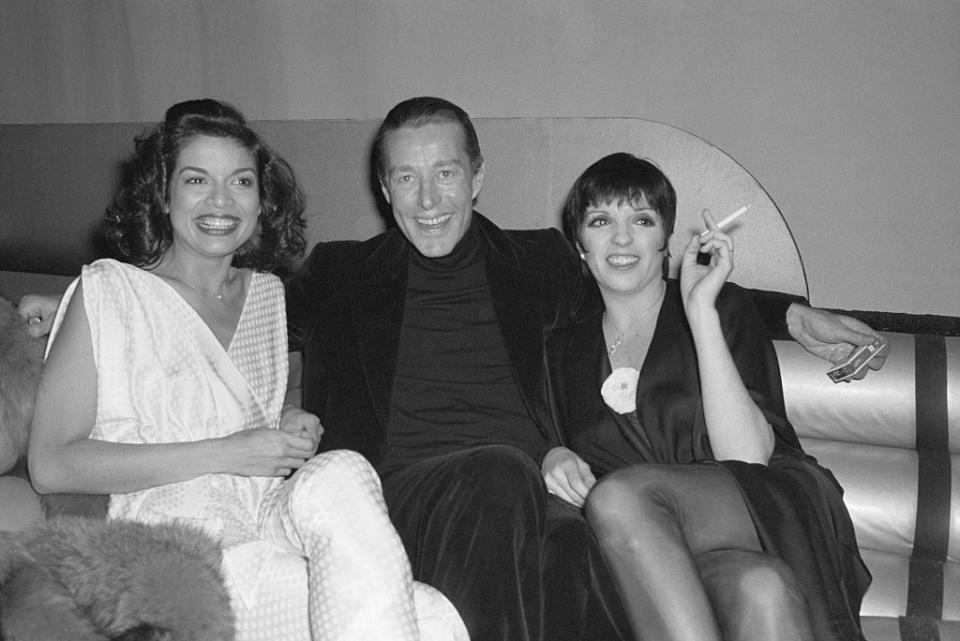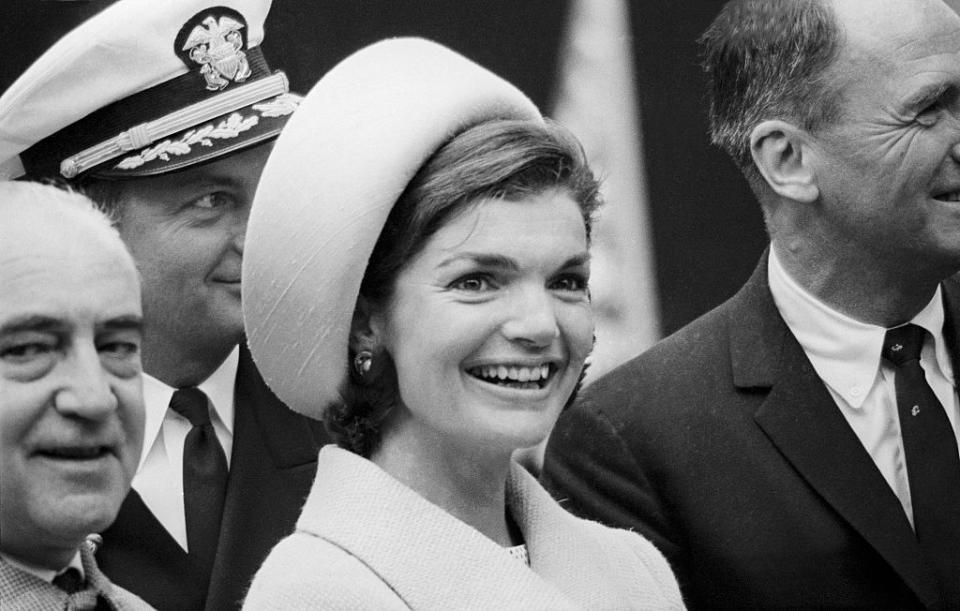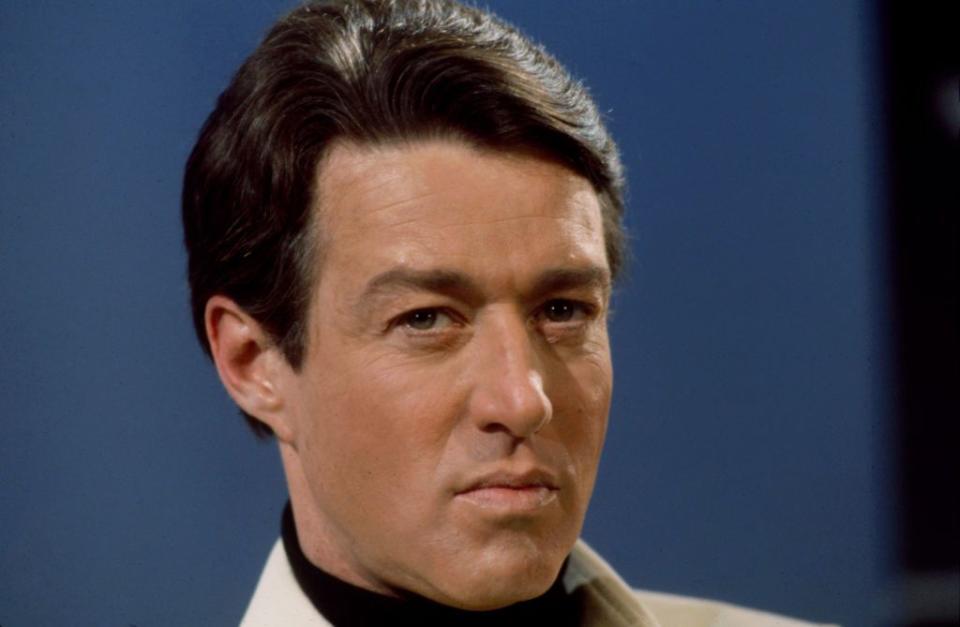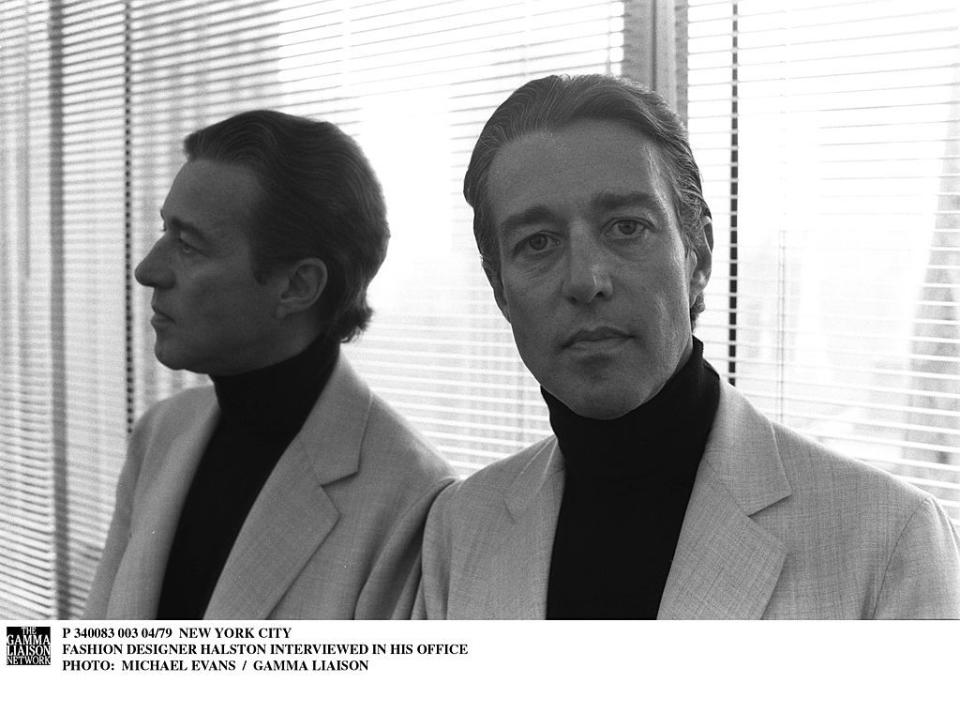The True Story of Halston, the Iconic Fashion Designer

- Oops!Something went wrong.Please try again later.
Few figures have made a more significant impact on American fashion than Halston. His clean, minimalist, and functional garments were hugely popular throughout the 1970s and 1980s, and the man himself became a true celebrity thanks to his affiliation with people like Liza Minnelli, Andy Warhol, and Bianca Jagger.
The influential designer's life is the subject of a new Netflix series from Ryan Murphy, aptly titled Halston. Ewan McGregor plays the lead role in the show based on Steven Gaines's biography, Simply Halston, which was published in 1991. Initially renowned for his work making women's hats, Halston's designs eventually expanded, and he made waves in the fashion world when he partnered with major brands and department stores.
With more eyes on the iconic designer's life, and the legacy he left after dying of complications from AIDS in 1990, here are the facts you should know about Halston before watching Murphy's new series.
Halston cut his teeth in Chicago before becoming a major figure in New York.
An excerpt of Simply Halston, published in Vanity Fair, gives a thorough overview of the man's early life. Originally born in Iowa, Roy Halston Frowick first found fashion success in Chicago, and moved to New York in 1958 when he was 26. He was renowned as a milliner, initially working for Lilly Daché before eventually moving to Bergdorf Goodman.
"He was probably the greatest hatmaker in the world, an absolute magician with his hands," influential fashion editor Diana Vreeland said of Halston in Simply Halston.
In the late '60s, Halston branched out on his own, starting a boutique in Manhattan. Then, he began to experiment with other types of garments. In The Courier Journal & Times piece cited by Vogue, Halston explained his philosophy around clothing design.
"The point is to be comfortable. If you have nice legs, by damn, you want to show them. We have to abandon the idea we all have to look alike," he said. "We have to do what’s best for ourselves. That’s the secret of fashion."
While he didn't invent it, he's know for pioneering the use of ultrasuede, and made hybrid shirtwaist dresses, inspired by men's dress shirts. He also created halter dresses in a variety of colors.
Huge stars like Liza Minnelli and Elizabeth Taylor loved Halston and his pieces.

During Halston's heyday, he was adored by some of the biggest stars of the 20th century. He was close with people like Warhol, Jagger, Minnelli, and Elizabeth Taylor, among others.
Minnelli, for instance, wore one of Halston's creations, a yellow dress, to the Academy Awards.
Jackie Kennedy, meanwhile, donned a Halston hat for her husband's 1961 inauguration as president, making an iconic fashion statement. She helped increase his cultural cache significantly. Kennedy even put a small dent in the hat trying to keep it from flying off in the wind, which other designers reportedly copied in their own pillbox hats.

The relationship between Halston and Warhol inspired both men creatively. Per Biography.com, Halston appeared on several of Warhol's TV programs, while the artist's flower prints inspired several of his designs for dresses and scarves.
Halston and his celebrity circle frequented New York's historic Studio 54. The 30th birthday Halston helped throw for Jagger was legendary because, according to Vanity Fair, Halston rode a horse around the club.
Many of Halston's famous friends appear in Ryan Murphy's netflix show. Liza Minnelli is played by Krysta Rodriguez, Joel Schumacher by Rory Culkin, and Elsa Peretti by Rebecca Dayan.
He was in a rocky relationship with artist and designer Victor Hugo.
Per Vanity Fair's Simply Halston excerpt, "Halston's personal life was rather bleak." In 1972, he met a young man from a call service who went by the name Victor Hugo, then 24.
The pair began living together, and Halston brought him into the fashion business, where he began to "dress the windows of Halston's boutique." This caused controversy in part because a previous boyfriend of Halston's, Ed Austin, also held that job, but was abruptly fired.
According to Gaines in an interview with New Now Next, the relationship between Halston and Hugo (played by Gian Franco Rodriguez in the Netflix series), was oftentimes chaotic.
"I think it was real love of a sort. It wasn’t the kind of romantic, sweet, tender, caring love. Victor was stealing stuff out of the house when Halston was dying. They had to lock him out of the house," Gaines said. "But Halston liked being humiliated and having the shock value of having Victor around. It was a whole other side to Halston. And Halston was a very sexual person and so was Victor."
Some around Halston attribute his eventual downturn to Hugo, per Vanity Fair. Hugo enabled the high-octane partying lifestyle that Halston found through Studio 54, and had a volatile personality of his own–even painting over some of Warhol's original portraits and eventually stealing art from Halston's home.
"That Venezuelan call boy was his downfall," André Leon Talley told The New York Times. "He was a grifter who clung on like a parasite, like a barnacle on a ship.”
Eventually, Halston "sold his name" and began to struggle personally.

As Gaines told New Now Next, Halston entered a personal spiral that involved drug use and anger issues. In 1973, he sold his company to Norton Simon Inc. for roughly $12 million in stock, seemingly signaling a move towards mass market sales.
In Vanity Fair, Gaines wrote about Halston's mounting personal drama. "He also seemed a bit more petulant and on edge, quick to lose his temper and spit out invectives like 'moron!' or 'idiot!' at those who displeased him. No doubt Halston’s fuse had been shortened because he was snorting cocaine on a regular basis," he wrote.
Later, per a New York Times piece from the era, JCPenney approached Halston in 1981 about a collaboration, and he developed a more inexpensive Halston III line for the department store.
"Either Halston nor the retail giant JCPenney built their reputations by doing the unusual. But when they recently joined forces, the move surprised many in the fashion industry," June Weir wrote.
Roland Ballester, who produced the Halston documentary, said that these decisions were broadly unpopular within the circles that had once loved Halston's work. "The fashion world took it as a grave offense," Ballester stated. "It wasn't just, 'Okay, we're going to slowly ease you out because you've changed direction.' It was this very dramatic, 'We're done with you,'" he told NonfictionFilm.com.
Despite these business successes, Halston grew frustrated, and in 1984, he bought back his company, which was then owned by Playtex. According to the Washington Post, Halston regained control of his made-to-order and ready-to-wear business.
The type of partnership Halston did with JCPenney has since become more common in fashion, as high-end designers like JW Anderson and John Elliott have done affordable collaborations with brands like UNIQLO and the Gap, respectively. At the time though, it was relatively unprecedented.
Halston died in 1990 due to complications from AIDS.

In the 1980s, Halston contracted HIV, which eventually developed into AIDS.
According to an L.A. Times obituary, Halston passed away at age 57 in San Francisco. Specifically, he died of Kaposi's sarcoma, a kind of AIDS-related cancer that he battled for 18 months.
Per the Associated Press, one of Halston's final acts was to sell the black Rolls-Royce he called his "dream car" and donate all the proceeds to fund AIDS research.
His eponymous brand continues to sell clean, elegant garments that draw on his unique contributions to the world of American fashion.
"He didn't think of himself as an artist, even, internally. He never talked about his work in that sense," Tcheng told NonfictionFilm.com. "At the end, he said very humbly before he died, 'I'm just a dress maker. That's what I do.' There's something really refreshing about that."
Since then, he's been the subject of numerous films.
Given Halston's impact on fashion, his celebrity circle, and the drama that permeated his life, it's no surprise that he's been the subject of much media. In addition to the Halston documentary and Ryan Murphy's new series, a 2010 doc titled Ultrasuede: In Search of Halston was also released.
Additionally, his work has been showcased in museum exhibits, including one titled Silver & Suede that highlighted his relationship with Warhol, Hats Off, which focused on his milliner work, and an expansive showing at the Nassau County Museum of Art.
The Halston trademark is currently owned by Xcel Brands, Inc.
Halston's company has had several different owners since his death. Per Women's Wear Daily (WWD), it was briefly under Revlon Inc., which just produced Halston fragrances. The clothing was revived in 1996 by Tropic Tex, and Halston proceeded to change hands several more times, including briefly receiving an investment from Jimmy Choo co-founder Tamara Mellon in 2007.
Though that relaunch fizzled, a new line was launched under the Halston umbrella, dubbed Halston Heritage "that was based on archival Halston designs," according to WWD. Presently, the Halston and Halston Heritage trademarks are owned by Xcel Brands Inc., a company which also owns the license for Isaac Mizrahi and Judith Ripka.
Halston is considered by many to be one of the first true stars of American fashion, and wherever the industry goes in the future it's likely that you'll still be able to detect his fingerprints.
You Might Also Like

